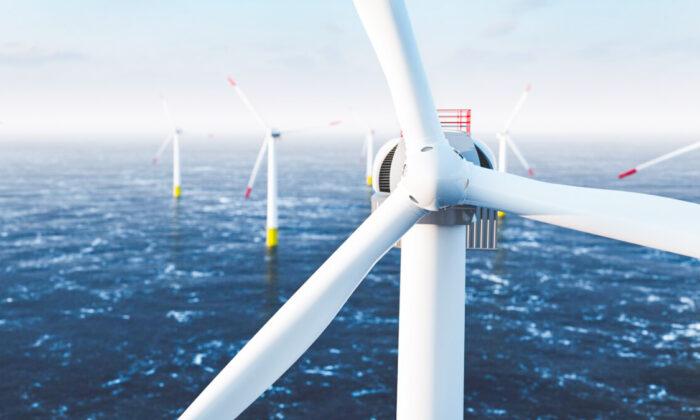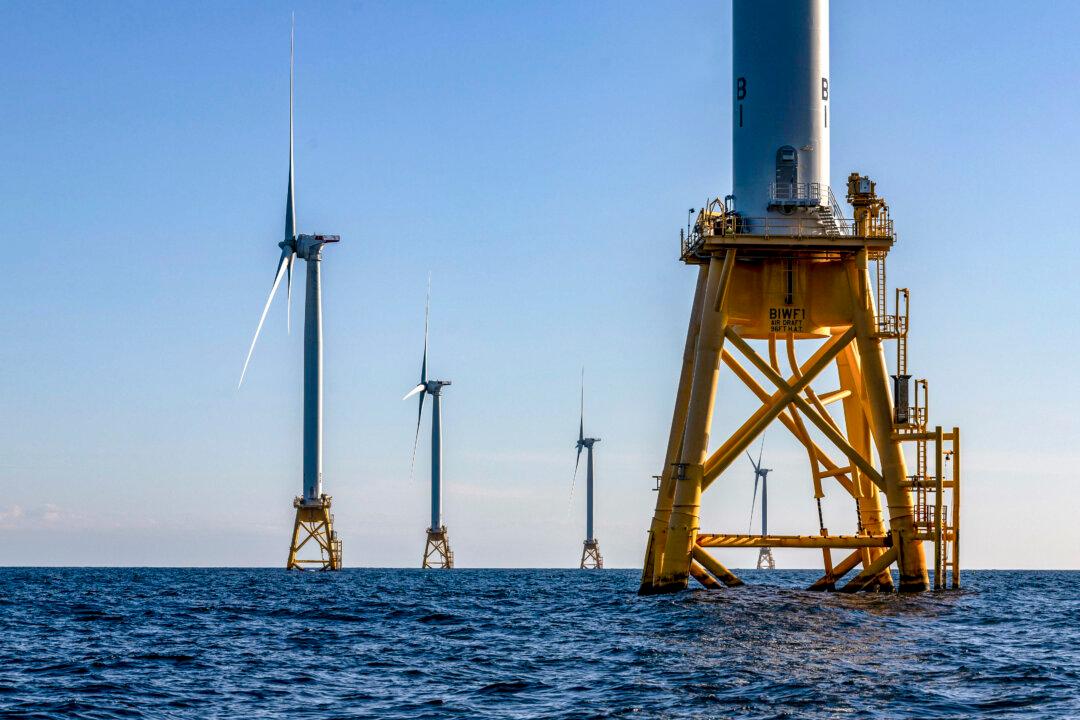The Biden administration announced on Feb. 22 that it has proposed the first-ever offshore wind lease sales in the Gulf of Mexico.
The administration proposed leases in three areas, covering 300,000 acres, which it said could potentially generate enough clean energy to power nearly 1.3 million homes.
The announcement comes as three congressmen and more than a dozen mayors whose coastal districts are near offshore wind energy sites are calling for a moratorium on new projects along the Eastern Seaboard until a thorough investigation into a recent spate of whale deaths can rule out wind farm activity as the cause.
Since December 2022, at least 25 whales have been found dead along the New Jersey, New York shoreline. Whales have also washed ashore in Maryland and Virginia.
Climate Agenda
The push for offshore wind energy is key to the administration’s climate agenda.
The goal is to generate 30 gigawatts of energy from fixed-bottom offshore wind farms by 2030, which it says could power 10 million homes, as well as 15 GW from floating offshore wind infrastructure by 2035, potentially providing power to 5 million homes.
The administration is moving quickly to reach that goal.
“We’ve announced a new offshore wind leasing strategy that includes seven lease sales by 2025,” said Department of the Interior Secretary Deb Haaland on Feb. 22, during a virtual Floating Offshore Wind Shot Summit.
Since President Joe Biden took office in January 2021, “the Bureau of Ocean Energy Management (BOEM) has already approved two major offshore wind projects and initiated the review of 10 more,” Haaland explained.
“Last year BOEM held three wind lease sales, including the largest offshore energy sale in history in New York, which yielded more than $4 billion in revenue,” she continued.
In December, BOEM held the first sale ever on the West Coast off the shores of California. The five California leases are also the first sale in U.S. history to support the use of floating offshore wind technology, she explained.
“These five lease areas have the potential to generate 4.6 GW of offshore wind energy, enough to power 1.5 million homes and support thousands of new jobs,” said Haaland.
The administration is now exploring potential wind sales in the deep waters off the Oregon coast as well as the Gulf of Maine and an area in the Central Atlantic.
“With two-thirds of the nation’s offshore wind potential in areas with deep water, we must reach areas we once thought were unattainable,” said Haaland.
Harnessing wind power over waters hundreds to thousands of feet deep requires the use of floating offshore technology.
This relatively new technology uses turbines, mounted on a floating platform that is anchored to the sea bed with mooring lines, unlike traditional wind infrastructure that is on a fixed platform anchored to the seabed.
Floating Offshore Wind Shot Summit
“Bringing floating offshore wind technology to scale will unlock new opportunities for offshore wind power off the coasts of California and Oregon, in the Gulf of Maine, Massachusetts, New Hampshire, and beyond,” Haaland said.
These floating installations are among the largest rotating machines ever constructed, with each tower the equivalent of stacking the Washington Monument atop the Statue of Liberty, and turbine blades more than 300 feet long.
The costs of the first floating offshore wind projects are estimated to be more than 50 percent higher than costs of fixed-bottom offshore wind. Pilot projects have already been deployed in Europe and Asia, with larger projects under development. In the United States, such projects are still in the early planning and development stage.
To expedite these projects and reduce their costs, the administration launched the Floating Offshore Wind Shot initiative.
On Feb. 22, the Departments of Energy, Interior, Commerce and Transportation convened the first “Floating Offshore Wind Shot Summit.”
“The Wind Shot program aims to bring the best ideas, creative thinking and collaboration” across public and private sectors and academia “to accelerate innovation, achieve cost reduction and employment goals, and establish the U.S. as a world leader in floating offshore wind,” explained Secretary Haaland.
Its ultimate goal is to reduce the costs of floating wind energy in deep waters by more than 70 percent, or $45 per megawatt hour, by the year 2035,” she added.
During the summit, U.S. Secretary of Energy Jennifer Granholm described what she called tangible benefits of the initiative. She believes it will deliver cleaner, cheaper, and more reliable energy while creating good paying jobs.
“This program is about investing in American innovation, bringing supply chains home, and creating jobs for welders and deckhands to the steelworkers who are making towers and other components inland and more,” said Granholm during the virtual summit.
“It’s all about making America more energy secure and energy independent.”
Providing clean, homegrown, distributed energy is key to a safe and secure future,” she added
The effort will require a “whole of government approach.”
It will also need funding.
Get Out the Green
Harnessing floating offshore wind will require massive investments in port renovations, an entirely new fleet of construction and service vessels, workforce training, seafloor mapping, environmental impact assessments, marine life inventory, outreach to ocean users, including fisheries, the lobster industry, and ocean tourism, and the labor community.
The administration said in a Feb. 22 press release that it would use the Inflation Reduction Act and Bipartisan Infrastructure Law to accelerate the growth of offshore wind by using clean energy tax credits to support manufacturing and deployment, as well as make investments in transmission and port infrastructure.
It believes this investment will create an economic boom.
Blue Economy Boom
Summit participants spelled out the massive jobs creation potential for building offshore wind.
“This undertaking requires training mariners, including the Merchant Marine, providing grant funding for port improvements and supporting the development of a unique fleet of vessels,” said the Administrator for the Department of Transportation Maritime Administration, Rear Admiral Ann Phillips, U.S. Navy (Ret.) during the virtual summit.
“Having the right vessel is key to deploying offshore wind energy infrastructure,” Phillips said.
These vessels must be compliant with the 1920 Jones Act, which requires vessels moving between two points in the United States to be built, owned, crewed, and registered in the United States. The Act applies to a vessel transporting turbine parts from a U.S. port to a project site that’s within federal waters.
Working in the challenging offshore environment requires highly specialized vessels for transporting, installing, and servicing the massive turbines as well as laying cable to the shoreline, transporting crews, and more.
These specialized vessels are already in short supply and none of the existing global fleet complies with the Jones Act.
The Maritime Administration plans to use U.S. Title 11 guaranteed loans to finance new construction of vessels of national interest.
“I recently designated vessels that service offshore wind infrastructure as vessels of national interest,” Phillips said. “These are the first service vessels to be so designated.”
Phillips expects a U.S. ship building boom as a result.
“We’ve already seen a surge in interest, and multiple applications for Title 11 help are already pending,” she said.
“Several American shipyards have already secured contracts to build vessels to serve offshore wind facilities,” Phillips said. This work will provide a needed boost to our domestic shipyards.”
Port Work Funding
In addition, multiple ports around the nation will need to be retrofitted or built to serve as launching platforms for construction and servicing of the ocean power infrastructure.
This work is being funded by the bipartisan infrastructure law and inflation reduction act.
“Between 2022 and 2027, the Port Infrastructure Development Program (PIDP) will invest $2.25 billion to strengthen ports across the nation, Phillips said.
“Last year, we awarded the first round of PIPD funding totaling $450 million.
An additional $234 million was provided for the PIDP in FY 2022 appropriations, bringing the total available last year to $703 million.
“From that program, we’ve already awarded approximately $93 million in PIPD grants to fund port infrastructure that will directly support offshore wind development.”
This year, Phillips said, her agency has more than $662 million in PIPD grants to let.
These massive public works improvements will create what Phillips called well-paying and highly technical jobs.
And the Floating Offshore Wind Shot has just begun.





